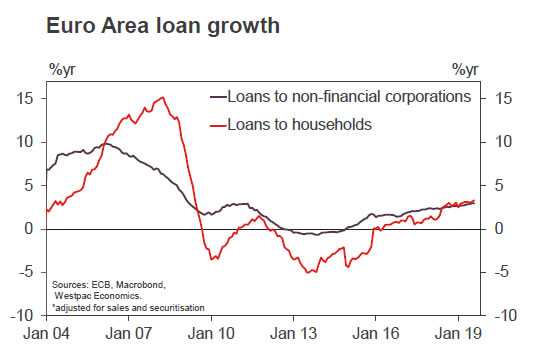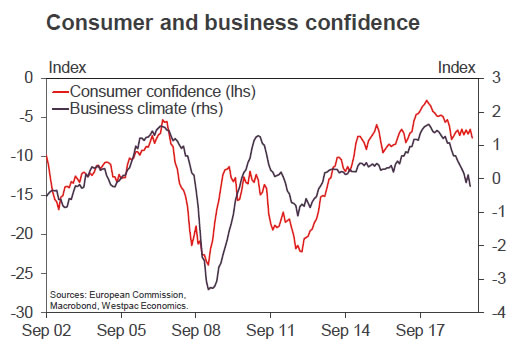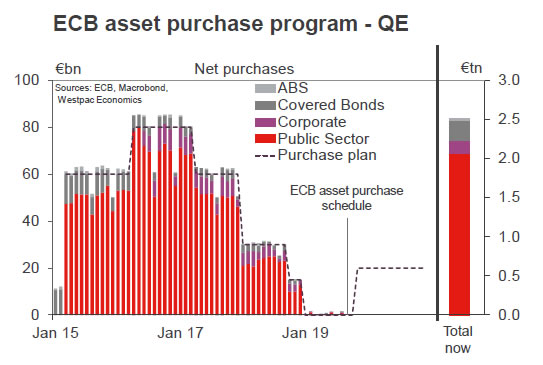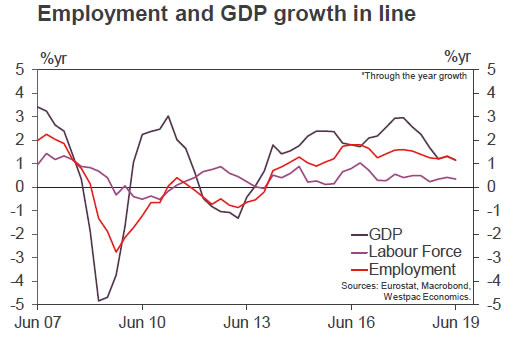The October ECB meeting saw policy left unchanged. This is no surprise given the stimulus package announced at the September meeting and that the October meeting does not involve macroeconomic projections. In addition, the ECB’s cautious assessment of the economy was also left unchanged. Accordingly, the focus of October’s press conference centred on further detail on September’s policy changes and reported disagreement within the Governing Council.
To recap, at the September meeting, the ECB cut the deposit rate 10bps to -0.5%, moved to a tiered reserve system (for each bank, a multiple of six times minimum reserves will be exempt from the deposit rate charge), restarted asset purchases (€20bn per month for as long as necessary), repriced TLTRO’s (10bps cheaper), and strengthened forward guidance.
All up, that represents a sizeable stimulus package but it was not unanimously agreed upon by the Governing Council. Some members had opined that the economic situation was not yet weak enough to justify such moves and the already flat yield curves were unlikely to benefit from further asset purchases. Many holding those views openly expressed their disagreement in the press.
Draghi was questioned on the lack of unity at October’s press conference. His response was blunt – all committees have disagreements, this was not the first time and it is part and parcel of deliberations. More firmly, he went on to note that, unfortunately, since the September meeting, all of the economic data has justified the Governing Council’s “determination to act” at the September meeting. A specific emphasis was put on the manufacturing PMI declining even further to 2012 lows.
Indeed, the introductory statement references “The incoming data since the last Governing Council meeting in early September confirm our previous assessment of a protracted weakness in euro area growth dynamics, the persistence of prominent downside risks and muted inflation pressures”.
On the specific details of the policy package, Draghi was similarly to the point.
The first issue regarding continued questioning on the efficacy of negative rates, he reiterated that on balance, they are effective in stimulating the economy.
The second issue is the limit on asset purchases. This relates to the ECB having an issuer limit along with a capital key rule which stipulates that a country’s share in the asset purchase program should equate to its share of capital in the ECB. As the ECB’s 20bn per month of asset purchases is open ended in terms of time, the ECB is likely to run up against its issuer limit on German and Dutch bonds at some point.
Here Draghi repeated the opinion of ECB Chief Economist Lane in that there is “quite a bit of time before this becomes a problem”. While he noted that the capital key is constant, the problem naturally relates to the stock of bonds outstanding and that is associated with respective country’s fiscal policy. If those countries with relatively less bonds outstanding in proportion to the size of the economies were to increase fiscal stimulus, there is unlikely to be a problem. That provided the perfect segway for him to repeat his call for countries with capacity to increase fiscal stimulus should act in an effective and timely matter.
So taking that all into account, the ECB continue to be concerned about the economic outlook and are still open to easing further.
Looking ahead, we think it is unlikely that ECB monetary policy will be adjusted at the December meeting despite our opinion that there is a need. This is because, as it will be the new President Lagarde’s first meeting in charge, and given the current disagreement within the Governing Council, there will be challenges in taking decisive policy action.
But that will change in time. In 2020, with our view that growth in the European economy remains subdued, we believe further ECB easing is in store at the March meeting with the deposit rate being reduced further to -0.6%.

















